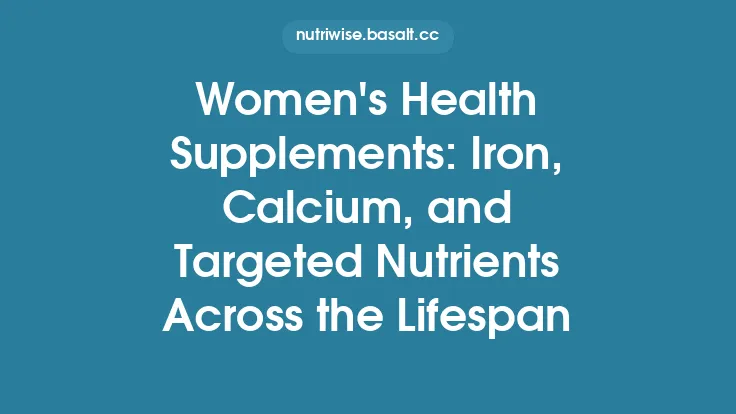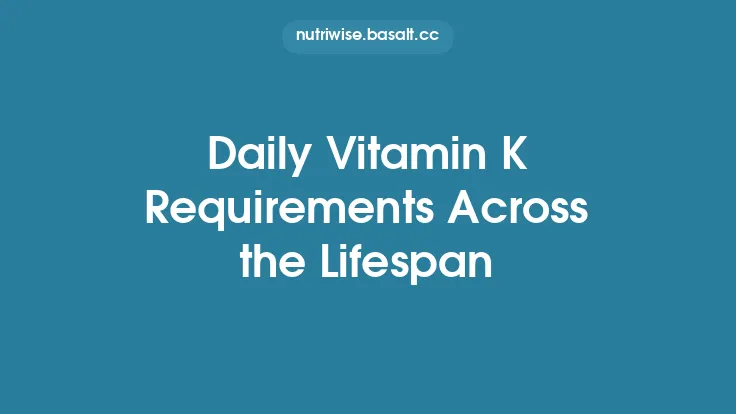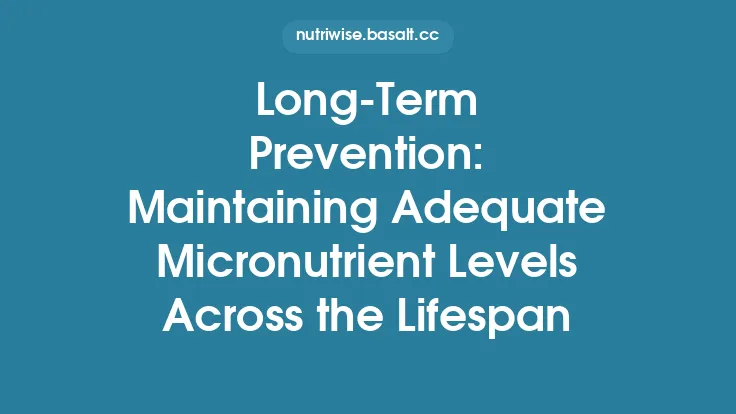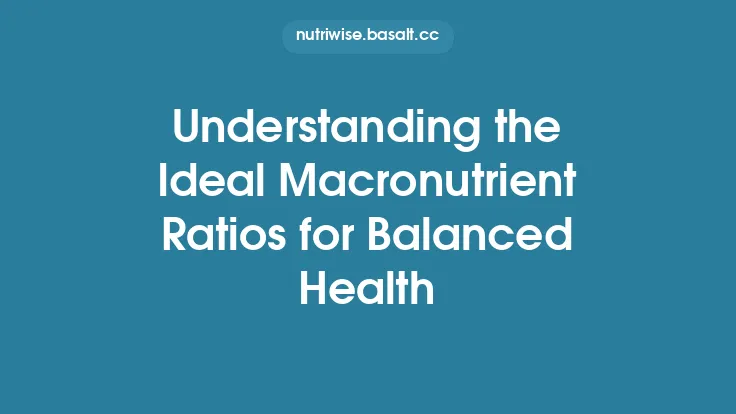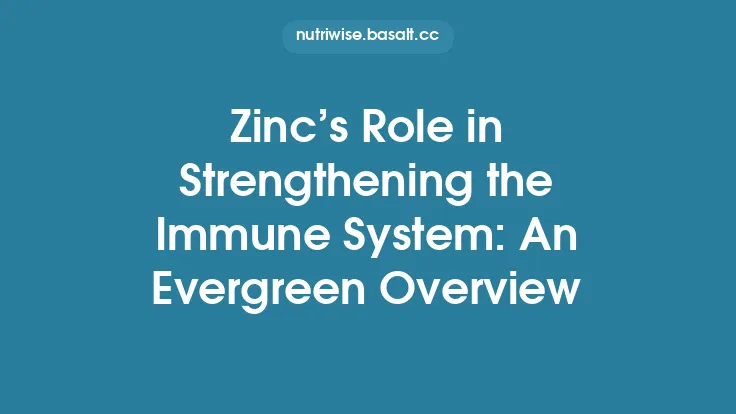Zinc is a trace mineral that the body cannot synthesize, so every gram we consume must come from the diet. Because zinc participates in the development and regulation of immune cells, maintaining an adequate daily intake is essential for a robust immune response throughout life. The amount of zinc needed, however, is not static; it shifts with age, physiological state, and environmental demands. Understanding how these variables interact helps individuals and health professionals design nutrition plans that keep zinc levels within the optimal window for immune competence.
The Biological Basis for Age‑Specific Zinc Needs
Growth and Development (Infancy–Adolescence)
During the first two years of life, rapid tissue expansion and organ maturation demand a higher proportion of zinc relative to body weight. Zinc is a co‑factor for DNA polymerases and ribosomal proteins, which drive cell division in the thymus, bone, and skin. Consequently, the recommended intake for infants (0–6 months) is set at 2 mg day⁻¹, rising to 3 mg day⁻¹ for toddlers (1–3 years) and 5 mg day⁻¹ for preschoolers (4–8 years).
Puberty and Adolescence
The surge in lean‑mass accretion, hormonal changes, and the onset of menarche in females increase zinc turnover. Adolescents (9–13 years) are advised to consume 8 mg day⁻¹ (girls) and 11 mg day⁻¹ (boys). For older teens (14–18 years) the values rise to 9 mg day⁻¹ (girls) and 12 mg day⁻¹ (boys).
Adulthood
In healthy adults, the primary determinants of zinc requirement are body size, muscle mass, and the baseline rate of protein synthesis. The standard reference values are 8 mg day⁻¹ for women and 11 mg day⁻¹ for men.
Pregnancy, Lactation, and Menopause
Pregnant women experience a 30–40 % increase in plasma volume and heightened fetal tissue growth, prompting an additional 2–3 mg day⁻¹ above the adult female baseline (total 11 mg day⁻¹). Lactating mothers need roughly 12 mg day⁻¹ to compensate for zinc secreted in breast milk. Post‑menopausal women often see a modest decline in zinc loss through the urinary tract, allowing the adult female recommendation to remain appropriate.
Older Adults (≥ 65 years)
Aging is accompanied by reduced gastric acid secretion, diminished intestinal transporter efficiency, and a higher prevalence of chronic low‑grade inflammation. Although the official Recommended Dietary Allowance (RDA) does not change after 65 years, many experts suggest a modest upward adjustment (≈ 10 mg day⁻¹ for men, 9 mg day⁻¹ for women) to offset reduced absorption and increased physiological stress.
How the Body Regulates Zinc Homeostasis
Zinc homeostasis is tightly controlled by a network of transporters (ZIP and ZnT families) and metallothioneins that buffer intracellular pools. When dietary intake exceeds immediate needs, excess zinc is sequestered in the liver and pancreas, then slowly released back into circulation. Conversely, during periods of scarcity, the body reduces intestinal absorption (from ~40 % to < 10 %) and increases renal reabsorption. This adaptive capacity explains why short‑term fluctuations in intake rarely cause acute deficiency, but chronic marginal intake can erode stores and impair immune cell function.
Factors That Modify Daily Zinc Requirements
| Factor | Mechanism of Influence | Typical Adjustment (if any) |
|---|---|---|
| Acute infection or inflammation | Cytokine‑driven redistribution of zinc to the liver; increased urinary loss | +10–20 % of RDA for the duration of illness |
| Intense physical training | Elevated muscle protein turnover and sweat loss | +5–15 % of RDA for athletes |
| High dietary phytate (e.g., whole grains, legumes) | Phytate chelates zinc, reducing absorption | Increase intake by 30–50 % or select phytate‑reduced foods |
| Gastrointestinal disorders (e.g., Crohn’s, celiac disease) | Malabsorption and mucosal damage lower uptake | +20–30 % of RDA, often combined with medical monitoring |
| Chronic kidney disease | Altered zinc excretion patterns | May require modest increase; monitor serum zinc |
| Alcohol dependence | Impaired hepatic zinc storage and increased urinary loss | +15–25 % of RDA |
| Use of certain medications (e.g., diuretics, proton‑pump inhibitors) | Reduced gastric acidity or increased renal clearance | +10 % of RDA, or consider timing of intake |
These modifiers are not absolute prescriptions; they serve as a framework for individualized assessment. Clinicians should evaluate the presence and severity of each factor before recommending an intake adjustment.
Practical Strategies for Meeting Age‑Specific Zinc Targets
- Use Food‑Based Planning Tools
National nutrient databases (e.g., USDA FoodData Central) provide zinc values per 100 g of food. By entering typical meals into a spreadsheet, individuals can quickly see whether they meet their age‑adjusted target.
- Prioritize High‑Bioavailability Sources
While the article on “Top Food Sources of Bioavailable Zinc” is off‑limits, it is still permissible to note that animal‑derived proteins generally offer higher absorption efficiency (≈ 30 % vs. 15 % for plant sources). This knowledge helps fine‑tune portion sizes without duplicating content.
- Balance Phytate‑Rich and Phytate‑Poor Foods
Pairing legumes with vitamin‑C‑rich fruits or employing soaking/fermentation techniques can lower phytate content, indirectly raising the effective zinc intake.
- Consider Timing with Meals
Zinc absorption is optimal on an empty stomach but may cause mild gastrointestinal discomfort. Splitting the total daily amount into two doses (morning and afternoon) can improve tolerance while still achieving the required total.
- Monitor Biomarkers When Feasible
Serum zinc, though influenced by acute-phase responses, can be used as a rough indicator of status when measured under fasting, non‑inflamed conditions. For high‑risk groups (elderly, pregnant women, athletes), periodic testing can confirm that dietary strategies are sufficient.
Special Populations and Tailored Recommendations
Infants on Breast Milk vs. Formula
Breast milk supplies zinc at a concentration that meets the infant’s needs for the first six months, after which complementary foods become essential. Formula‑fed infants receive a standardized zinc content (≈ 2 mg L⁻¹) that aligns with the RDA.
Vegetarians and Vegans
Because plant foods contain phytate, vegetarians often require 30–40 % more dietary zinc to achieve the same absorbed amount as omnivores. Strategies include emphasizing zinc‑dense nuts, seeds, and fortified products, and employing preparation methods that reduce phytate.
Individuals with Chronic Illness
Patients with HIV, chronic liver disease, or autoimmune disorders experience heightened zinc turnover. Clinical guidelines frequently suggest a modest increase (10–20 % above the standard RDA) coupled with regular monitoring.
Pregnant Athletes
Women who combine pregnancy with high‑intensity training may need to add both the pregnancy increment (≈ 3 mg) and the training increment (≈ 2 mg), totaling roughly 13–14 mg day⁻¹.
Calculating an Individual’s Daily Zinc Goal: A Step‑by‑Step Example
- Identify Baseline RDA
- 30‑year‑old male: 11 mg day⁻¹
- Add Adjustments for Lifestyle
- Moderate endurance training: +10 % → +1.1 mg
- Account for Dietary Inhibitors
- Predominantly plant‑based diet with high phytate: +30 % → +3.3 mg
- Sum the Values
- 11 mg + 1.1 mg + 3.3 mg = 15.4 mg day⁻¹
- Round to Practical Target
- Aim for 15 mg day⁻¹, achievable through a combination of animal‑source meals (if tolerated) and fortified plant foods.
Frequently Asked Questions (Beyond the Scope of Neighboring Articles)
Q: Does the body store zinc long‑term?
A: Zinc is stored primarily in the liver, pancreas, and skeletal muscle, but the total reserve is modest (≈ 2–3 g). Because the pool is limited, regular dietary intake is essential to sustain immune function.
Q: Can zinc requirements be met solely through supplements?
A: While supplements can bridge shortfalls, relying exclusively on them bypasses the synergistic benefits of whole foods (e.g., accompanying amino acids that aid transport). Moreover, excessive supplemental zinc can interfere with copper absorption and cause gastrointestinal upset.
Q: How does menopause affect zinc needs?
A: Post‑menopausal women experience a slight decline in urinary zinc loss, but the change is not large enough to warrant a formal RDA adjustment. Maintaining the adult female recommendation (8 mg day⁻¹) is generally sufficient, provided overall diet quality is high.
Q: Are there seasonal variations in zinc needs?
A: Seasonal changes in infection rates can temporarily raise zinc turnover, but the increase is usually modest (≈ 5 %). Rather than altering the baseline RDA, a short‑term dietary emphasis on zinc‑rich foods during peak illness periods is advisable.
Key Takeaways
- Age, sex, and physiological state dictate baseline zinc requirements; infants need as little as 2 mg day⁻¹, while adult men require about 11 mg day⁻¹.
- Absorption efficiency varies with diet composition; phytate‑rich foods lower bioavailability, prompting higher intake targets for plant‑dominant eaters.
- Acute stressors (infection, intense exercise) and chronic conditions (GI disease, alcohol use) modestly raise daily needs; adjustments of 10–30 % are typical.
- Practical planning tools, portion control, and occasional biomarker checks help ensure that individuals meet their personalized zinc goals without overreliance on supplementation.
- Tailoring intake across the lifespan supports a resilient immune system while respecting the unique metabolic demands of each life stage.
By integrating these evidence‑based guidelines into everyday nutrition planning, readers can confidently navigate the lifelong journey of maintaining optimal zinc status for immune health.
